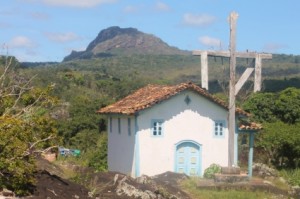
Photo © Michael Sommers.
Last weekend, when my boyfriend’s housemate, Nadia, invited me to accompany her on a trip to visit a quilombola community 50 km from Diamantina, I jumped at the chance.The Brazilian term quilombo comes from kilombo, an expression that, in the Kimbundu language spoken by various Bantu peoples in Angola and Congo, originally referred to a resting place for nomads or travelers. However, upon migrating to colonial Brazil, quilombo acquired a new meaning, becoming a designation for autonomous communities founded by runaway slaves.
Between 1530 and 1888, when Brazil became the last country in the Western Hemisphere to abolish slavery, an estimated 3.5 to 4 million slaves crossed the Atlantic from Africa to Brazil.Between 1530 and 1888, when Brazil became the last country in the Western Hemisphere to abolish slavery, an estimated 3.5 to 4 million slaves crossed the Atlantic from Africa to Brazil. Throughout this period, some slaves were able to buy their freedom. Others escaped into the remote wilds of the Brazilian interior and formed quilombos. By eking out a living from subsistence farming, many of these communities managed to live for generations, undetected, while preserving elements of the languages and cultures, religious and social traditions that their ancestors had brought with them from Africa.
Initially, the majority of slaves were brought to work the sugar cane plantations of Northeastern states such as Bahia and Pernambuco. But in the 18th-century, when massive amounts of gold and diamonds were discovered in the mountainous region that stretched inland between Bahia and Rio de Janeiro, hundreds of thousands of slaves were brought in to work the mines of the region that subsequently became known as Minas Gerais (“General Mines”). Those that escaped and founded quilombos often continued to pursue gold and diamond mining on a small scale.
Today, over 1,500 comunidades quilombolas – communities descended from the original quilombos founded by runaway slaves – have been officially recognized in Brazil by the federal government’s Fundação Cultural Palmares (many more have still to receive this official status). Over 430 of these are located in Minas Gerais.
Quartel do Indaiá is one of the most recently “recognized” comunidades quilombolas; it received its official status as such in December of 2011. And yet, the fewer than 100 residents and nine main families that comprise the community are descendants of several quilombos that date back to the 1740s and to the beginning of diamond mining in the region surrounding Diamantina.
In order to control the flow of fortune seekers into the so-called “Diamond District”, and to keep contrabandists from smuggling out precious stones, the Portuguese crown (which wanted all the rocks for itself), established a series of military posts (quartéis) placed at strategic points near diamond-rich rivers and creeks. One of these was Quartel do Indaiá, located 9km from the village of São João da Chapada, on the banks of the Rio Caeté-Mirim.
I was given much of this information by Nadia and her friend and colleague, Sílvio, as we left Diamantina early Saturday morning en route to Quartel. There was lots of time for talking since it took us almost 90 minutes to navigate the red dirt roads that meandered through a striking landscape of layer upon layer of mountains, covered in rocky outcrops and native Cerrado vegetation.
Our surroundings became much more remote – not to mention more lush – as we left the tiny town of São João da Chapada and headed down into a picturesque valley. For close to half an hour, we were driving in the midst of a captivating green nowhere. And then suddenly, we rounded a curve and came face to face with Quartel’s 25 houses, whitewashed colonial church, primary school, and three bars (the only local commerce).
A professor of nutrition, Nadia knows Quartel and its residents well. As research for her doctoral thesis, which deals in part with slaves’ diets, she recently rented a house in Quartel and spent six months carrying out extensive interviews with members of the community. Having forged ties with the population, she still has a key to the house and visits regularly.
Upon our arrival, we stopped in the small two-room casinha to drink some filtered water and share a shot of cachaça before heading out to explore the settlement and the surrounding landscape of red rivers, exuberant vegetation, and stunning mountain views.
Read the next part of this article.